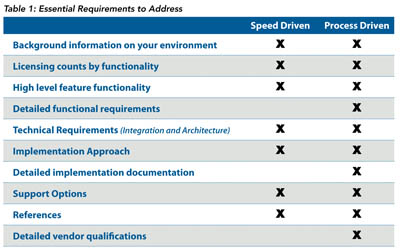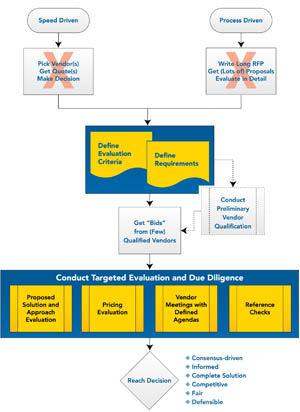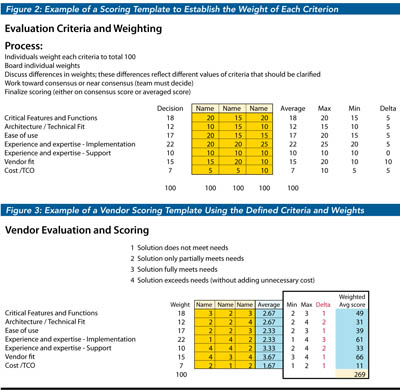Optimizing Technology Selection



Ever feel like Goose and Maverick from Top Gun: “I feel the need, the need for speed”? Impatience at senior levels, inability to invest that leaves you dangling with end-of-life or end-of-support products, and change taking place in “Internet Years” all combine to make speed the No. 1 driver for many technology pursuits. At the other end of the spectrum, many suffer from painful procurement processes that demand RFPs, a minimum of six bidders, and timelines that seemingly drag on forever. Heaven forbid you get the double whammy demands of “Do it fast while using our rigorous procurement process!” Either extreme poses unnecessary risks. Go too fast and you miss crucial information, bypass attractive options, or forego completeand competitive pricing. Get too complicated and you bury the truly essential in a sea of detail and delay realization of valuable business benefits. You can eliminate these risks and decrease pain by streamlining the requirements definition process and conducting targeted due diligence. Focus on what really matters and you’ll find the right (and complete) solution, approach and price to deliver what your center needs.
Keys to Success
A successful technology selection process includes the following steps:
- Identify criteria that will differentiate vendors and solutions
- Define requirements that focus on the specific needs of the center and IT for this project
- Determine appropriate vendors to consider based on high-level requirements
- Document the requirements in appropriate vendor communication
- Evaluate options through targeted due diligence, using the criteria that matter to you, ensuring an apples-to-apples comparison
- Bring the team to consensus on the “best” vendor and solution
Refined processes can ensure that you remain in control, while keeping things moving at a decent pace, and appeasing procurement or others who require formality. Figure 1 shows how technology purchases can benefit from following these steps.
Define selection criteria
A crossfunctional team of contact center, IT and procurement staff defines the selection criteria that guides the rest of the evaluation process. Consider criteria beyond basic feature/ functionality as many vendors are at or near parity on common capabilities. Ease of use, the ability to deliver and support the solution, platform infrastructure, application integration, implementation processes and resources, training and knowledge transfer approaches, and support after going live are often important. And with the wide-ranging sourcing options, vendor maturity, and partnering, “vendor fit” can be another important criterion for some.
Here are some factors that can make a difference:
- Does the architecture meet your IT requirements for operating systems, virtualization, data centers, servers and security?
- Do they have experience integrating with your back-office systems?
- Do they have experience in delivering solutions in your industry, or of similar size and scope?
- What are the qualifications of the resources to implement and support the system?
- Do they have a proven track record of delivering a solution on time, without scope creep (and surprise costs)?
- How do they handle knowledge transfer?
Price is noticeably absent from the “top” criteria. It is certainly important, but it’s negotiable and thus relegated to secondary importance. You want to get a deep understanding of all the other criteria first and then use that knowledge to influence subsequent dialogue with the “preferred” vendor.
Document requirements
A requirements document can be a structured for your business needs. And get your numbers ready: licenses by media (voice, email and/or chat are most common), number of supervisor and reporting resources, number of inbound and outbound trunks, licenses for testing and training, etc.
Technical Requirements
Define the network, hardware and software requirements for servers in the data center and desktops in the contact center. Address specific hot buttons for areas such as reliability, resiliency, scalability, integration and security. The vendor platform requirements could impact your overall project costs if you need to upgrade infrastructure or provide hardware. Now is the time to find out!
Implementation Approach
Implementation approaches are not created equal; some are downright disappointing. If you want to meet or exceed expectations, dive into these important areas:
- Approach for discovery, project management, collaboration, etc.
- Timelines for each major phase, including design, development, testing and cutover
- Roles and responsibilities for them and for you
- Testing types, plans, tools and resources
- Training of various sorts, including: classroom, on-site, train-the-trainer, knowledge transfer
Suport
It’s not just about business hours or 24/7. Find out who does what and what the service level commitments and escalation processes entail. Probe on warranties, upgrade processes and perhaps even their release history and roadmap, if you’re wondering where they’ve been and where they’re going.
Vendor Fit
Gather some important documents for review by those who worry about the prospective partners’ financials and contracts. Secure information on their experience and fit (projects of similar size, vertical, solutions, etc.) and the all-important references. And if they are bringing partners into the mix (for products or services), this section should require information on them, as well.
Pricing
Provide vendors with a spreadsheet for them to complete to drive an apples-to-apples comparison of hardware, software, implementation and support services. Ask for base pricing and discount levels to find out how serious they are about seeking your business.
Identifying apropriate partners
If you want to select the right solution and vendor, start with the right candidates. There’s a world of choice in products, services and sourcing options, such as hosted or “cloud-based.” A little time investment up front can go a long way in getting you off on the right foot. These days, education on options comes free and easy. Vendors offer webinars and are more than willing to set up focused presentations (remote or live) for you and your team. These preliminary steps help get a feel for both the product and the partner and help rule things in or out early. To go a step further, we are big fans of simple questionnaires asking 10 to 20 pointed and very important questions to qualify prospects. Want to make sure they have enough experience in your market, size or existing technology environment? Want to quickly assess if they can meet your timeline, provide hand-holding services or do it all for you? Responses to short, targeted inquiries save everyone a lot of time and trouble if the “fit” isn’t there. Where distributors are the delivery channel, the company selling, implementing and supporting the solution can be as important as the hardware and software. Take time to find the right ones with the right experience. You can even screen several providers of the same product without having to evaluate a full bid from each. You’ll quickly ascertain with whom you do—and don’t—want to have a long-term relationship.
Gather information and compare vendors
This is the point that you begin to tie everything together. With targeted bids based on the defined requirements, create a matrix using your evaluation criteria. The matrix should include columns for pros, cons, issues and questions. This format makes it easy to glean what is relevant from the responses. Map pricing to components to ensure that you are comparing apples to apples.( See the sidebar on pricing components.)
Upon completing your initial review of the responses, you can narrow the field to your short list of vendors. Continue your evaluation by checking references and holding vendor presentations. Maintain control by providing the vendors with a detailed agenda that identifies what you want them to cover during their presentations. Structure the agenda around issues that surfaced during your review so each presentation fills gaps in understanding. This step may require multiple meetings to address what is important to the contact center (functions, interfaces, etc.) and IT (architecture, integration, etc.).
Make the selection
The most important part of choosing is building consensus so that all stakeholders own and support the final decision. Circle back to the original criteria to create a common focus in decision-making. Build a scoring template that allows each team member to score the vendors on the differentiators. Figure 2 shows how an evaluation team might establish the weight of each criterion. Figure 3 shows how this same team might score a vendor response based on the defined criteria and weights. While it’s best to use the average, weighted score to determine the vendor that most nearly meets all requirements, differences in scoring can drive much-needed conversation in consensus building. Tools such as this can remove the emotions often attached to solutions or vendors, and help you “defend” the decision to leadership that must approve a purchase.
Choosing the “Best” Solution
As we all know, no vendor or product is perfect. There are always tradeoffs to find the best solution to meet your center’s needs. The good news is that you can apply a thorough yet tightly managed process to sort through your options. As you do, you will identify those tradeoffs and determine the best answer for your particular situation—all in a reasonable timeline with a solid outcome that you can feel confident has a complete and competitive price. Throughout this process, the entire team will learn valuable insights that help make the next step—implementation—smoother and less painful for all.
Pricing Components
Contact centers have difficulty comparing prices due to the differing responses and formats that vendors submit. We suggest a pricing template that requires vendors to divide pricing into the following components and explain in detail what is included in each section and what is not.
- Separate pricing for each product or service category
- Separate pricing for each location
- For each location and product/service category include:
- Hardware included and what the buyer must provide
- Software licenses by site, server, or agent (specifying concurrent or named)—include quantities, price for each, the extended price, any discount applied and total price
- Implementation professional services
- Maintenance fees—percentage of list price or bid price per year
- Any options for which pricing was requested in the RFP broken out in the same categories as above
– Reprinted with permission from Contact Center Pipeline, www.contactcenterpipeline.com







